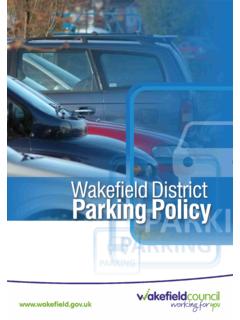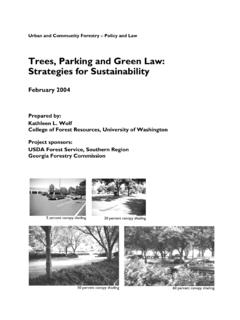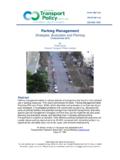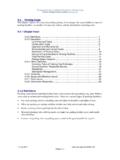Transcription of Summary of the draft Parking Policy 2019-2022
1 Summary of the draft Parking Policy 2019-2022 Parking affects almost everyone that lives, works or visits Croydon. The competition for road space from pedestrians, cyclists, vehicles and Parking is growing, in particular in areas where new homes are being built and outside schools. The draft Parking Policy sets out the aims and objectives for 2019 to 2022 for Parking services; to manage the demand, improve air quality in Croydon by encouraging less reliance on cars and the use of lower emitting vehicles, and improving safety outside the borough s schools. The draft Policy has six core principles. This Summary version focusses on the new aspects for Parking services, all business as usual activity has been removed. The full version can be viewed on our website Section 1 - Collaborative working Aim: Joint working across council departments to embed a clear approach that aligns and coordinates Parking in Croydon to meet national, regional and local guidance.
2 Objectives: Finding solutions to facilitate the changing demands of Croydon roads to allow for more cycle Parking , cycle lanes, car clubs, EVCPs (Electronic Vehicles Charging Points), and borough-wide new developments. Reviewing and developing conditions for deliveries to businesses and homes, new EVCPs and car club (shared/hire cars) for all residents. Consider introducing Traffic Management Orders (legal documents that regulate the use of the highways for movement and Parking and off-street Parking within the borough) in parks and housing estate car parks, which includes consultation through a public notice and approval by the relevant decision maker. Review the future Parking management of different vehicle types such as two-wheeled vehicles ( motorbikes, scooters) and delivery and passenger transport vehicles ( black cabs and minicabs).
3 Section 2 - Parking management Aim: Provide suitable and adequate Parking facilities on and off the highway, without impacting the quality of the streets and to ensure a swift, convenient and safe flow of vehicles and other traffic. This includes contributing to the over-reaching Policy aim of reducing car use and increasing walking, cycling and the use of public transport. Objectives: Fairly balance Parking capacity, Parking times and bay types to make the most of them and meet the wide-ranging needs of all road users prioritising: o emergency services, vulnerable road users, disabled people, people with special access needs and sufficiency for car clubs and EVCP users. o main roads for efficient, safe and congestion free flow for vehicles, public transport, cycles and pedestrians. o needs of local residents for Parking near to home. o equal access for all users in streets near to commercial, retail, healthcare and leisure locations.
4 O safe walking and cycling near schools. Maintenance of approx. 1,500 Parking spaces and 17 off-street car parks ensuring: o signs and lines are clear o car parks are clean and safe Any new, amended or withdrawn on-street Parking spaces go through the Traffic Management Order process, which includes consultation through a public notice and approval by the relevant decision maker. Ensure we have the resources to enforce in compliance with the legislative framework and approved code of practice to: o ensure compliance with road traffic laws (Highway Code) and local Traffic Management Orders o enforce in places where inconsiderate Parking results in congestion, impacts on highway safety and delays access for emergency services o enforce misuse of EVCPs Section 3 - Controlled Parking Zones (CPZ) Aim: Manage Parking where demand exceeds supply or unsafe conditions exist, through the design of permitted and restricted kerb space that fairly balances Parking capacity, Parking times and bay types (residential, P&D, business and shared use) in accordance with the locations and as appropriate to the needs of local communities and businesses.
5 Objectives: Understand the impacts of the significant growth in the borough on Parking and proactively find solutions for managing increased demand. Section 4 - School streets Aim: Contribute to securing a healthy and safe environment near to schools, and to help children and parents use cars less and to walk, cycle and use public transport more. Objectives: Introduce school streets in agreement with schools and where appropriate for local traffic conditions. New, amended or withdrawn school streets must go through the Traffic Management Order process, which includes consultation through a public notice and approval by the relevant decision maker. Review enforcement and/or school crossing patrols by schools where a school street cannot be implemented, but where traffic impacts are proven to have a potentially negative impact on safety and general order.
6 Section 5 - Parking charges Aim: Operate the charges defined in local Traffic Management Orders for on- and off-street Parking places. Objectives: Introduce emission based charging to encourage a shift to zero and low emission vehicles. New and amended Parking charges must go through the Traffic Management Order process, which includes consultation through a public notice and approval by the relevant decision maker. Section 6 - Innovation and technology Aim: Create an open data platform where we can publish, share and use data to enable innovation in transport related information systems. Objectives: Better use of technology within the service including more mobile cashless payment apps and digital systems, to gradually substitute pay and display machines. Review and consider the introduction of virtual loading bays. As part of the council s smart city transformation, opening up data available to be used for real-time travel information.
7 This document is a Summary , the full version can be found on our website






